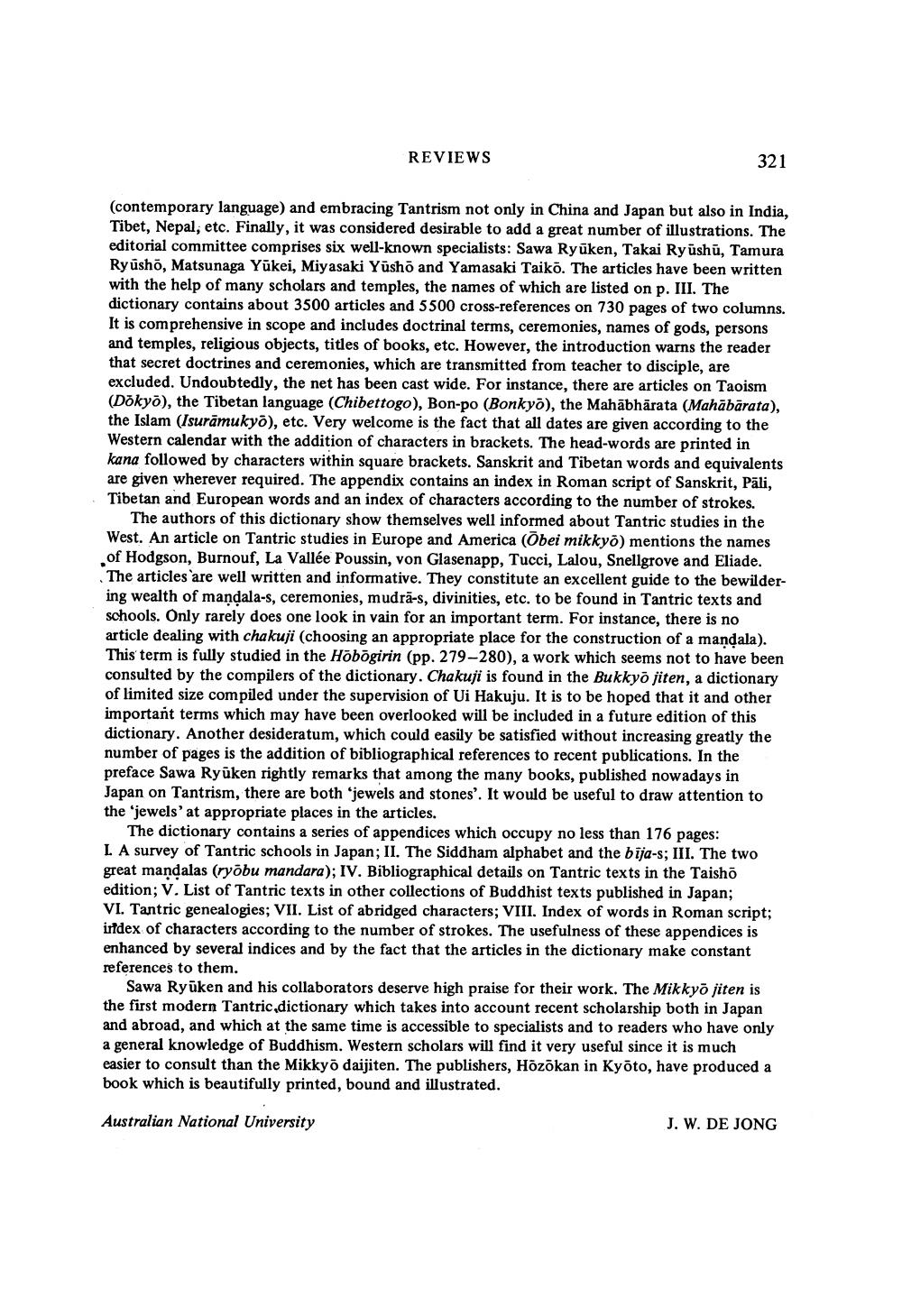________________
REVIEWS
321
(contemporary language) and embracing Tantrism not only in China and Japan but also in India, Tibet, Nepal, etc. Finally, it was considered desirable to add a great number of illustrations. The editorial committee comprises six well-known specialists: Sawa Ryūken, Takai Ryūshū, Tamura Ryūsho, Matsunaga Yükei, Miyasaki Yusho and Yamasaki Taiko. The articles have been written with the help of many scholars and temples, the names of which are listed on p. III. The dictionary contains about 3500 articles and 5500 cross-references on 730 pages of two columns. It is comprehensive in scope and includes doctrinal terms, ceremonies, names of gods, persons and temples, religious objects, titles of books, etc. However, the introduction warns the reader that secret doctrines and ceremonies, which are transmitted from teacher to disciple, are excluded. Undoubtedly, the net has been cast wide. For instance, there are articles on Taoism (Dokyo), the Tibetan language (Chibettogo), Bon-po (Bonkyo), the Mahābhārata (Mahābārata), the Islam (Isurāmukyo), etc. Very welcome is the fact that all dates are given according to the Western calendar with the addition of characters in brackets. The head-words are printed in kana followed by characters within square brackets. Sanskrit and Tibetan words and equivalents are given wherever required. The appendix contains an index in Roman script of Sanskrit, Pāli, Tibetan and European words and an index of characters according to the number of strokes.
The authors of this dictionary show themselves well informed about Tantric studies in the West. An article on Tantric studies in Europe and America (Obei mikkyo) mentions the names of Hodgson, Burnouf, La Vallée Poussin, von Glasenapp, Tucci, Lalou, Snellgrove and Eliade. The articles are well written and informative. They constitute an excellent guide to the bewildering wealth of mandala-s, ceremonies, mudrā-s, divinities, etc. to be found in Tantric texts and schools. Only rarely does one look in vain for an important term. For instance, there is no article dealing with chakuji (choosing an appropriate place for the construction of a mandala). This term is fully studied in the Hõbõgirin (pp. 279-280), a work which seems not to have been consulted by the compilers of the dictionary. Chakuji is found in the Bukkyo jiten, a dictionary of limited size compiled under the supervision of Ui Hakuju. It is to be hoped that it and other important terms which may have been overlooked will be included in a future edition of this dictionary. Another desideratum, which could easily be satisfied without increasing greatly the number of pages is the addition of bibliographical references to recent publications. In the preface Sawa Ryūken rightly remarks that among the many books, published nowadays in Japan on Tantrism, there are both 'jewels and stones'. It would be useful to draw attention to the 'jewels' at appropriate places in the articles.
The dictionary contains a series of appendices which occupy no less than 176 pages: L A survey of Tantric schools in Japan; II. The Siddham alphabet and the bija-s; III. The two great mandalas (ryõbu mandara); IV. Bibliographical details on Tantric texts in the Taisho edition; V. List of Tantric texts in other collections of Buddhist texts published in Japan; VI. Tantric genealogies; VII. List of abridged characters; VIII. Index of words in Roman script; irfdex of characters according to the number of strokes. The usefulness of these appendices is enhanced by several indices and by the fact that the articles in the dictionary make constant references to them.
Sawa Ryūken and his collaborators deserve high praise for their work. The Mikkyo jiten is the first modern Tantric dictionary which takes into account recent scholarship both in Japan and abroad, and which at the same time is accessible to specialists and to readers who have only a general knowledge of Buddhism. Western scholars will find it very useful since it is much easier to consult than the Mikkyo daijiten. The publishers, Hõzõkan in Kyoto, have produced a book which is beautifully printed, bound and illustrated.
Australian National University
J. W. DE JONG




